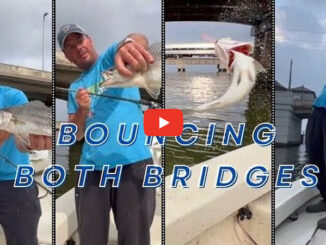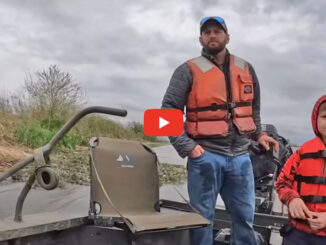Crawfish at night to fill sacks of mudbugs in no time
Many people love to go set-netting for crawfish, but few go during the prime feeding hours, when net frames bend from mudbugs spilling over all four sides as you rush toward the bank. Yes, you can fill a sack with a half dozen nets in less than an hour when hitting it right.
By “right,” I mean “night.”
Sitting around in the sun patiently waiting for craws to slowly crawl to your nets like usual? Think again buddy. You’ll be raising those nets as fast as you put them out; otherwise, all you’ll be raising is cleaned out fish bones.
Better yet, at times you can fill the sack by just grabbing mudbugs or scooping them with a net. No messy bait required.
Watch the attached video to see just how effective crawfishing at night can be.
Feeling lazy? Do this from the 4-wheeler and get a pot-load of crawdads without taking a step in the water. I definitely don’t condone the lazy part, but boy it’s a fun way to use your ATV.
Growing up crawfishing with traps and nets in the swamps surround Lake Des Allemands, I learned clever ways of catching the tasty critters. Those were some long days when I’d wake in the dark to walk and paddle miles of swamp before school to raise several dozen cages. Then, having to go to morning track practice, class, afternoon track practice and top it off with baseball practice.
But, no matter how tired I was, waking at the crack of daylight to catch some big redpaws to sell was the best part of my day.
My track opponents were always baffled with my response to training questions where I’d replied, “My secret? Running through the swamp with sacks of crawfish so I’m not tardy for school.”
Nowadays, my favorite place to catch crawfish is the Mississippi River, which is home to many white river crawfish that get slightly larger than red swamp crawfish that are also found in river ponds. The crawfish in river ponds along South Louisiana don’t reach their peak until mid-June, so there is plenty of time left to catch them this year, as most crawfish are still small.
The Mississippi has endless ditches and ponds that are loaded with crawfish. I know a lot of people catch crawfish on the side of the road, but fishing in sewage and oil runoff waters isn’t for me.
Every night is a different experience with river craws. Some nights the crawfish are really skittish, while other nights they’ll stay in place letting you grab them by hand in the water.
As the night wears, they’ll travel from deeper water to right up against the bank. The best nights are when they are crawling on the bank itself: Easy pickings.
A bonus is when you see a crawfish lying on its side, appearing to be dead. These are soft-shell crawfish, and are the best to eat. They are the equivalent of a soft-shell crab. One night we caught hundreds of these soft-shells.
The bigger crawfish go through a late-spring molt in June, so that’s when you’ll have more luck because mature crawfish molt less often. Be sure to take out the two hard crystals behind the soft-shell’s eyes before cooking.
When night crawfishing with a scoop net slows, using set nets is a sure thing. Bigger crawfish hide during the day and come out during night hours. I usually catch double and triple the amount in half the time at night. Having one-two dozen keeper crawfish per net with a five-minute soak is common in river ponds. Try not to shine your light at the net when lifting, as sometimes crawfish spook.
Make sure your lift pole has a hook at the end and is light weight. Cane poles work great because of their lightness and strength.
Feeling like you’re lifting a brick? Get ready to grab a tail because a turtle is bowing you down. Most likely it’ll be a red-eared slider, but you never know when you’ll get lucky and have a mean snapper.
If going during the day, be sure to muddy up the water surrounding your set-net or go at dawn or dusk. Overcast days are the best. I recommend finding new spots during the day, and look for plenty of vegetation in the water.
When setting cages, I look for lily pads. There is always well-oxygenated swamp water with ample aquatic vegetation for them to eat where the lilies are. I’ve had the most success with floating cages by using 2-liter coke bottles in lily pads where the water is deep, leaving the bait dangling just below the lilies.
Never raise a trap by hand because a mad moccasin could be caught in the cage with its head sticking out free to bite even if the body is stuck with all your crawfish in its now fattened belly.
For bait in nets and traps I like to use sardines or fish heads. A big fish head will catch craws for a long time because they can’t eat it fast. Melt works OK, too, but nothing is as effective as fresh fish.
My latest trip was on a good, cloudy day where we caught well during the last hour of daylight and the action picked up significantly after sundown. The crawfish were being skittish, staying in deeper water with the on-setting cold front. So we had more success on the set-nets that night.
Every round checking the nets was averaging a dozen crawfish after just sitting a few minutes until the few fish heads I brought were used up. The size of the crawfish after dark increased, as the big ones came out to feed. Certain ponds had larger crawfish than others.
That’s all there is to it. Head to the mighty Mississippi at night with a light, a scoop net and a few set-nets from now through June and you’ll have a fun time easily catching a sack or two of crawfish.


